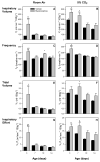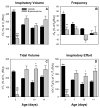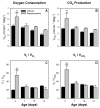Chronic in utero buprenorphine exposure causes prolonged respiratory effects in the guinea pig neonate
- PMID: 20043989
- PMCID: PMC2854243
- DOI: 10.1016/j.ntt.2009.12.007
Chronic in utero buprenorphine exposure causes prolonged respiratory effects in the guinea pig neonate
Abstract
Our laboratory studies the effects of in utero opioid exposure on the neonate. In this work we test the effects of chronic in utero exposure to buprenorphine on the neonate. Buprenorphine is a promising candidate for treatment of opioid addiction during pregnancy and it has been suggested to decrease the neonatal abstinence syndrome in human infants. In our guinea pig model, we focused not only on the respiratory effects of in utero exposure on the neonate, but also studied withdrawal signs in the neonate, a major concern of all opioid treatment during pregnancy. Pregnant guinea pigs were treated with daily subcutaneous injections of 0.1mg/kg buprenorphine during the second half of gestation. We measured weight, locomotor activity and respiratory function in pups of ages 3 to 14 days. Respiratory response was recorded using a two-chamber plethysmograph, while pups were breathing either room air or 5% CO(2). Our results show that chronic in utero exposure to buprenorphine induces respiratory effects up to day 14 after birth, while earlier studies have shown that effects of either in utero methadone or morphine only persist in the first week after birth in the guinea pig model. These data provide important information for clinical trials of buprenorphine treatment suggesting that duration and severity of respiratory effects of in utero buprenorphine exposure should be monitored.
Conflict of interest statement
The authors and author’s institution have no financial or other relationships with other people or organizations that would constitute a conflict of interest.
Figures



Similar articles
-
Respiratory effects of chronic in utero methadone or morphine exposure in the neonatal guinea pig.Neurotoxicol Teratol. 2008 Sep-Oct;30(5):448-54. doi: 10.1016/j.ntt.2008.03.063. Epub 2008 Mar 21. Neurotoxicol Teratol. 2008. PMID: 18442893 Free PMC article.
-
Chronic intermittent in utero exposure to morphine: effects on respiratory control in the neonatal guinea pig.Biol Neonate. 1997;72(5):293-304. doi: 10.1159/000244496. Biol Neonate. 1997. PMID: 9395840
-
Methadone-induced respiratory depression in the neonatal guinea pig.Pediatr Pulmonol. 2007 Dec;42(12):1134-43. doi: 10.1002/ppul.20707. Pediatr Pulmonol. 2007. PMID: 17968993
-
Use of buprenorphine in pregnancy: patient management and effects on the neonate.Drug Alcohol Depend. 2003 May 21;70(2 Suppl):S87-101. doi: 10.1016/s0376-8716(03)00062-0. Drug Alcohol Depend. 2003. PMID: 12738353 Review.
-
Neonatal ventilatory changes following in utero cocaine exposure: a minireview of the guinea pig and rabbit models.Neurotoxicology. 1995 Spring;16(1):153-7. Neurotoxicology. 1995. PMID: 7603636 Review.
Cited by
-
Prenatal Opioid Exposure Enhances Responsiveness to Future Drug Reward and Alters Sensitivity to Pain: A Review of Preclinical Models and Contributing Mechanisms.eNeuro. 2020 Oct 15;7(6):ENEURO.0393-20.2020. doi: 10.1523/ENEURO.0393-20.2020. Print 2020 Nov-Dec. eNeuro. 2020. PMID: 33060181 Free PMC article. Review.
-
Pharmacokinetics and Adverse Effects of 3 Sustained-release Buprenorphine Dosages in Healthy Guinea Pigs (Cavia porcellus).J Am Assoc Lab Anim Sci. 2017 Nov 1;56(6):768-778. J Am Assoc Lab Anim Sci. 2017. PMID: 29256372 Free PMC article.
-
A novel, non-invasive method of respiratory monitoring for use with stereotactic procedures.J Neurosci Methods. 2012 Aug 15;209(2):337-43. doi: 10.1016/j.jneumeth.2012.06.029. Epub 2012 Jul 4. J Neurosci Methods. 2012. PMID: 22771713 Free PMC article.
References
-
- Belcheva MM, Bohn LM, Ho MT, Johnson FE, Yanai J, Barron S, Coscia CJ. Brain opioid receptor adaptation and expression after prenatal exposure to buprenorphine. Developmental Brain Research. 1998;111:35–42. - PubMed
-
- Blake CI, Banchero N. Ventilation and oxygen consumption in the guinea pig. Respir Physiol. 1985;61:347–355. - PubMed
-
- Boothby LA, Doering PL. Buprenorphine for the treatment of opioid dependence. Am J Health Syst Pharm. 2007;64:266–272. - PubMed
-
- Cepeda MS, Farrar JT, Baumgarten M, Boston R, Carr DB, Strom BL. Side effects of opioids during short-term administration: effect of age, gender, and race. Clin Pharmacol Ther. 2003;74:102–112. - PubMed
Publication types
MeSH terms
Substances
Grants and funding
LinkOut - more resources
Full Text Sources

